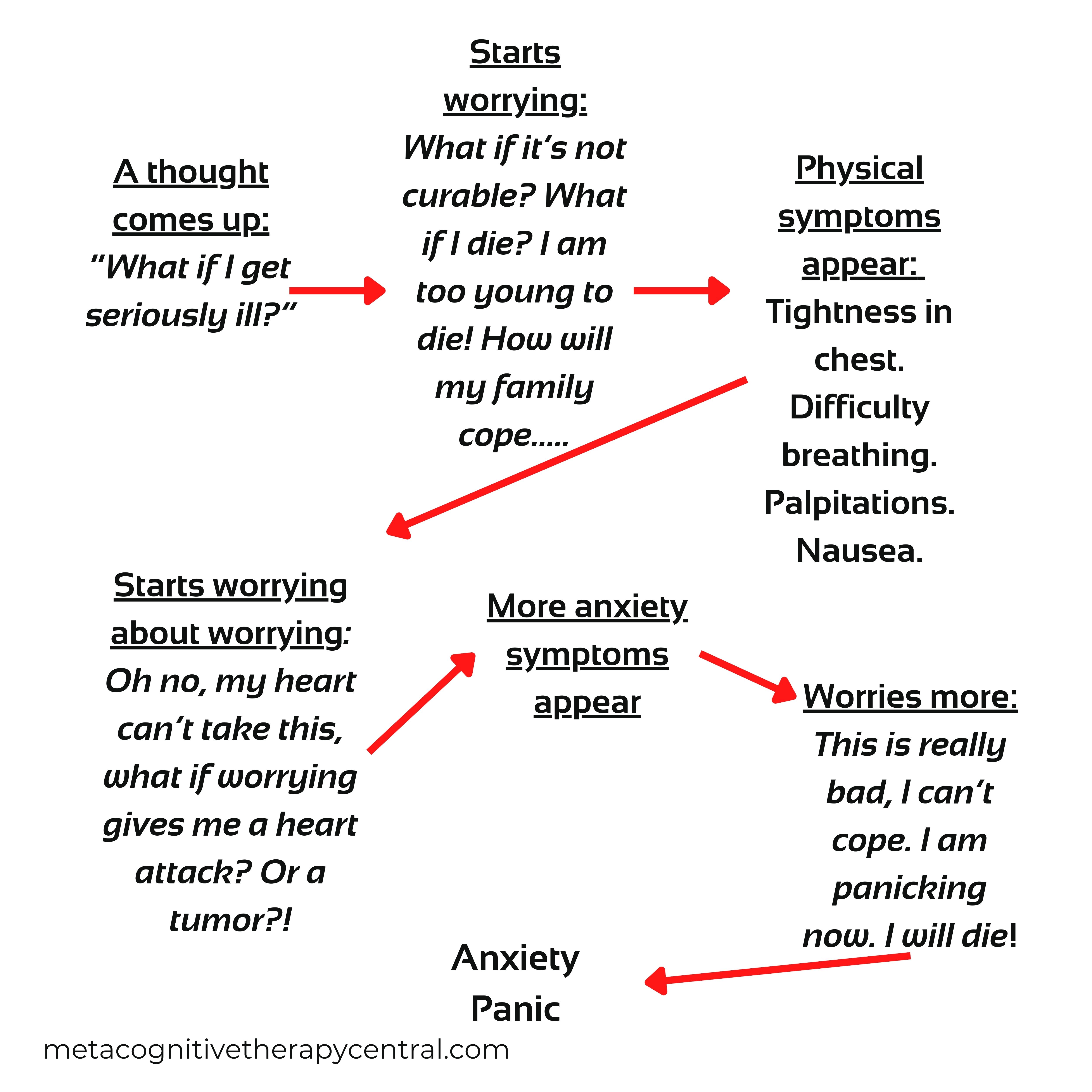
If you think back to ten of your past worries, how many of them led you to solutions? Were they good solutions? And did these solutions come from worrying or did you engage in constructive problem-solving?
Problem-solving involves clearly defining a problem, brainstorming solutions, and taking action. That is different form worrying, were we focus excessively on our worst fear and spiral downward with thoughts of catastrophes.
But often, we think that worrying helps us deal with future catastrophes better. And be prepared for the worst. If you are someone who worries in an attempt to solve personal, relational, financial, health-related, or any other problem, you are probably blocking yourself from dealing with these problems effectively. And it’s time to adopt a better strategy: problem-solving.
Worrying is going over your thoughts in your head, imagining worst-case scenarios, and asking a lot of what-if questions: “What if something bad happens?” “What if I fail?” “What if I get rejected?“
How to problem-solve instead of worrying
In order to think logically and find solutions to our problems, effective problem-solving requires five major components. These include:
1) Problem orientation (is this problem within my control?)
2) Problem definition and goal identification (what is the problem and what is my goal?)
3) Generating solutions (brainstorm solution A, B, C…)
4) Decision-making (When exactly am I going to take action?)
5) Implementation (Implement solution on specific time)
As shown in this sequence, problem-solving is more tangible and help you create an action plan you can implement to deal with your problem. It helps you move forward and closer to your goal. Worrying on the other hand, usually leads to anxiety, tension, and in some instances, more confusion.
Here is an example of someone worrying vs. using problem-solving to create a healthier lifestyle:


Even though you don’t have to stick exactly to the problem-solving steps mentioned above, having a structure for problem-solving is helpful. This helps prevent problem-solving from turning into just another way of constantly overthinking (worrying) that impacts your mood negatively.
For instance, some people like to set aside a specific time each week for problem-solving, such as half an hour every Sunday. During the rest of the week, they focus on going to work, studying, spending time with friends and family, and simply living their lives – all without letting their problems consume their thoughts all the time.
Encountering problems is an inevitable part of life, and according to Metacognitive therapy, you can still enjoy a fulfilling life WHILE having problems. The idea behind using problem-solving instead of worrying is to cut down on the total time you spend thinking too much about your problems, so that you can focus on other things as well.
| Worrying | Problem-solving |
|---|---|
| I can’t believe I have gained so much weight. I can barely fit into my clothes. I look fat and I’m sure my wife thinks this too. Maybe that’s why she doesn’t want to be close to me. I am unattractive and lazy… | I have gained a few kilos and I don’t like that I can’t fit into my clothes. Starting this weekend, I will get back on my healthy meal plan and start exercising 3 times per week. |
| Moving to a new area is difficult. We have to start all over and make new friends. What if we don’t find good people to spend time with? What if I end up feeling lonely when my husband is away for work? Will I ever be happy about moving away from our friends and family? What if… | Making new friends can take some time and in the meantime, I can give all my attention to my kids and spend quality time with them. I have heard that they have a great church community here. I am planning to go next week and see if I connect with some nice people there. |
| What if I never get comfortable talking to women? I always choke when I am around them and have nothing interesting to say. It’s so awkward and sad. What if I end up lonely and depressed? | Every time I am out with my friends, I will practice talking to three women for a couple of minutes. If I do this for a few months, I will slowly feel more comfortable talking to women. |
Steps to follow when problem-solving
Allow yourself a 30-minute problem-solving time each week to solve your problems instead of worrying about them.
Sit down with pen and paper and
- Define your problem and decide whether it’s solvable (Can I do something about this problem?)
- Come op with different solutions (Write down all your ideas/solutions for solving this problem and don’t worry whether they are good enough at this point)
- Choose one solution that makes the most sense (and plan when to act on it. Make sure to be as specific as possible)
- Implement that solution on the time and day you had planned.
- If this solution doesn’t work, choose the next from your list and implement.
TIP: You can break down your problem into smaller steps. For example, James has a super important project where he needs to give a presentation to clients. He decides to break it into smaller parts. First, he gets all the info together. Then, he makes slides with pictures and charts. Finally, he practices how to talk about it. To make it even easier, he plans specific times for each step, like picking pictures on one day and making charts on another. This way, the big task becomes more doable when divided into smaller tasks.
What are the benefits of problem-solving?
Problem-solving is quick, and it gives you a plan to follow, making you feel in control of problems or tough situations. Problem-solving, compared to worrying, is a clear and helpful process that helps us find specific solutions to a problem. Problem-solving drives us forward and closer to our goals, as well as making it possible to take action based on our cores values.
For example, the decisions we tend to make based on worrying are usually motivated by fear. And the goal of that decision is to extinguish the fear. However, solutions based on extinguishing fear don’t necessarily align with our values. For example, worrying about getting fired may generate solutions like working longer hours, which compromises our values of spending quality time with our families. While problem-solving an unstable work situation gives us the opportunity to take into account our core values of being a committed family member AND a decent employee.
A study showed that when people problem-solved their problems instead of worrying about them, not only did they come up with better solutions, but they also felt more confident that these solutions would help them overcome their problems, compared to people who only worried about their problems (1).

Why does worrying not help with solving problems?
According to Metacognitive therapy, worrying is the leading cause of anxiety disorders. For example, people with generalized anxiety disorder tend to worry so much, that they make themselves sick. And they also worry about how much they are worrying, creating a downward anxiety spiral.

When we worry, we focus excessively on our worst fear. And this makes us even more anxious and can cause symptoms like tightness in the chest, palpitations, stomach ache, and the feeling of dread that leaves us paralyzed to do anything but dwell on this terrible future that we think is waiting for us.
For example, Jenna is leading a major project for her company. The project involves multiple variables and uncertainties and Jenna worries excessively about potential obstacles, budgetary concerns, and the project’s overall success.
Instead of focusing on the tasks at hand, she often gets caught up worrying about everything that might go wrong. This worry takes up a lot of her attention and makes it tough for her to make decisions on the spot. The worrying also makes it harder for her to think clearly and make smart choices, let alone addressing a the important things happening right now in the project.
Worrying makes us fear something that is typically unlikely to happen. Contrary to what we believe, worrying doesn’t help us be more prepared; instead, we end up with no specific plan to solve this future problem and a lot of anxiety. In essence, worrying is a destructive process that makes us focus on problems that haven’t happened yet and doesn’t produce any good solutions if the problem did happen.
Worrying also makes it harder for us to ignore irrelevant information. Imagine you are in a situation where you are really concerned about how your colleagues see you at work. You might be worried that they judge your decisions or opinions. Now, this worry can make you very vigilant to what everyone around you is saying or doing – not just your colleagues, but even people you barely know. You notice more how people react to what you say and do, making it harder to stay focused on your own goals and priorities.

If worrying is unhelpful, why do we do it?
According to some research, people worry because they don’t know how to solve problems. And unfortunately, many people don’t know that worrying and solving problems are not the same thing. They think that they are problem-solving when they are just worrying.
According to Metacognitive therapy, we worry because we have specific beliefs about worrying (also called metacognitive beliefs). These beliefs convince us that worrying is helpful (If I worry, I’ll be more prepared for the future) or that worrying is unstoppable (I can’t stop worrying). When these beliefs are activated, we keep worrying even when worrying leads to mental health conditions like anxiety.
Metacognitive therapy (MCT) is a successful mental health treatment because it helps people reduce worry and change false metacognitive beliefs that worrying is unstoppable.
Can all worries be problem-solved?
Not all problems are easily solvable. Some problems are beyond our control or involve uncertain future events, that may not even come true.
Here are some examples of “unsolvable” worries:
- Unpredictable future events: Worrying about unexpected future events, like accidents, illness, loss, or natural disasters, may not have immediate solutions. While you can take precautions, you can’t eliminate all uncertainties.
- Other people’s opinions: If you’re worried about what others think of you, their opinions are beyond your control. You can’t change how everyone perceives you, and attempting to do so may lead to unnecessary stress and low self-esteem.
- Past mistakes: Worrying about things you’ve done in the past that you cannot change is unproductive. It’s essential to focus on learning from those experiences rather than dwelling on them.
- Weather-related worries: You might worry about a rainy day during your planned outdoor event. While you can check the weather forecast and make some preparations, you ultimately can’t control the weather.
- Global or societal concerns: Concerns about world events, such as political situations or global economic trends, might be challenging to solve on an individual level.
In my experience as a clinical psychologist, 98% of all the things my clients worry about, are potential “what-if” scenarios that rarely come ture. My advice is therefore to practicing reducing how much time you spend worrying about problems, whether you think your worries are realistic or not. Use worry postponement, which is an effective strategy for reducing worrying, especially if your goal is to have a better mental health and overcome anxiety.
Would you like to try Metacognitive therapy to reduce worrying? Book an intro session and get a personalized plan for how you can learn to reduce worry and overthinking to get a better mental health.
References
- Llera SJ, Newman MG. Worry impairs the problem-solving process: Results from an experimental study. Behav Res Ther. 2020 Dec;135:103759. doi: 10.1016/j.brat.2020.103759. Epub 2020 Oct 27. PMID: 33129156; PMCID: PMC7703801.
